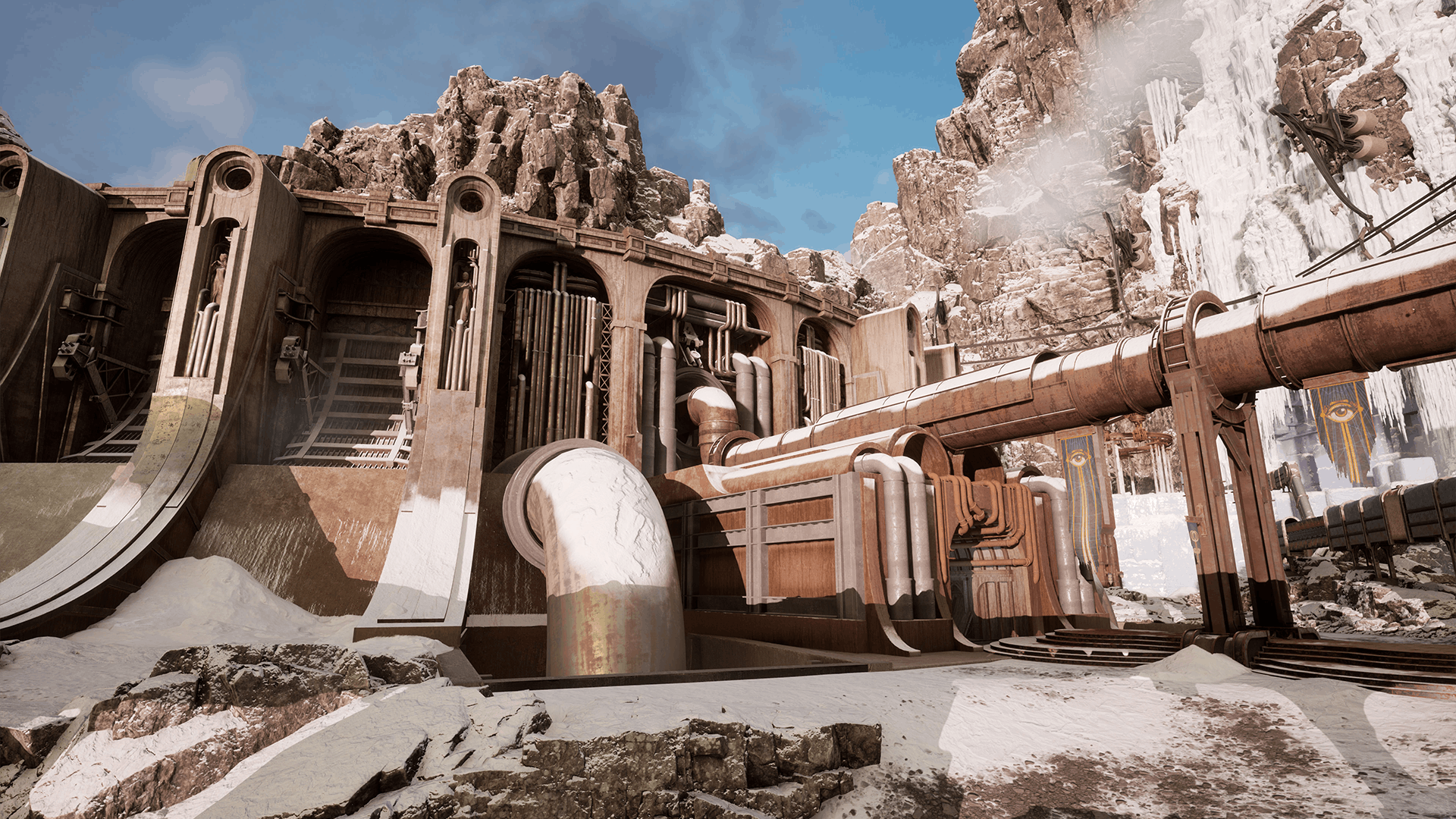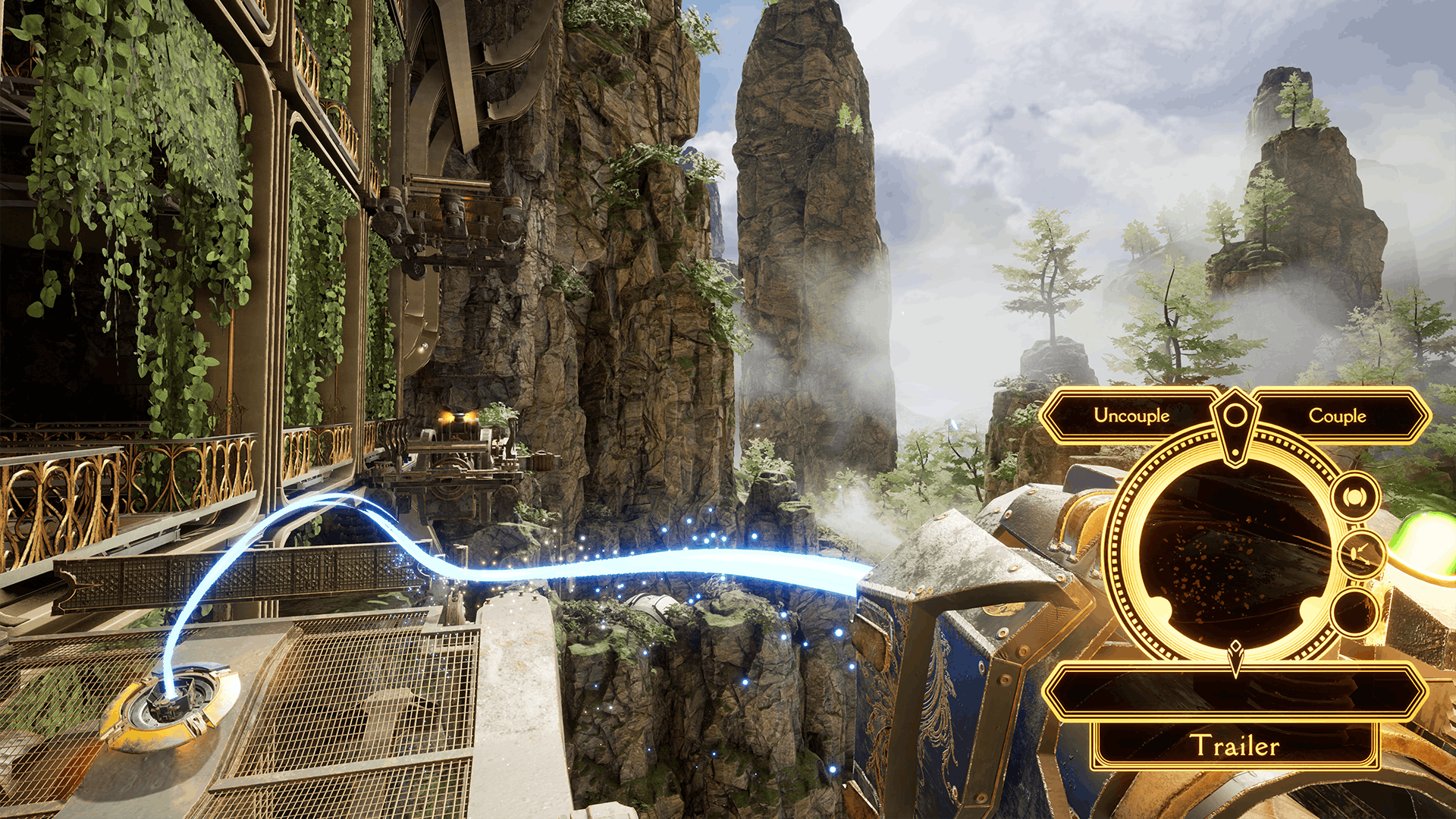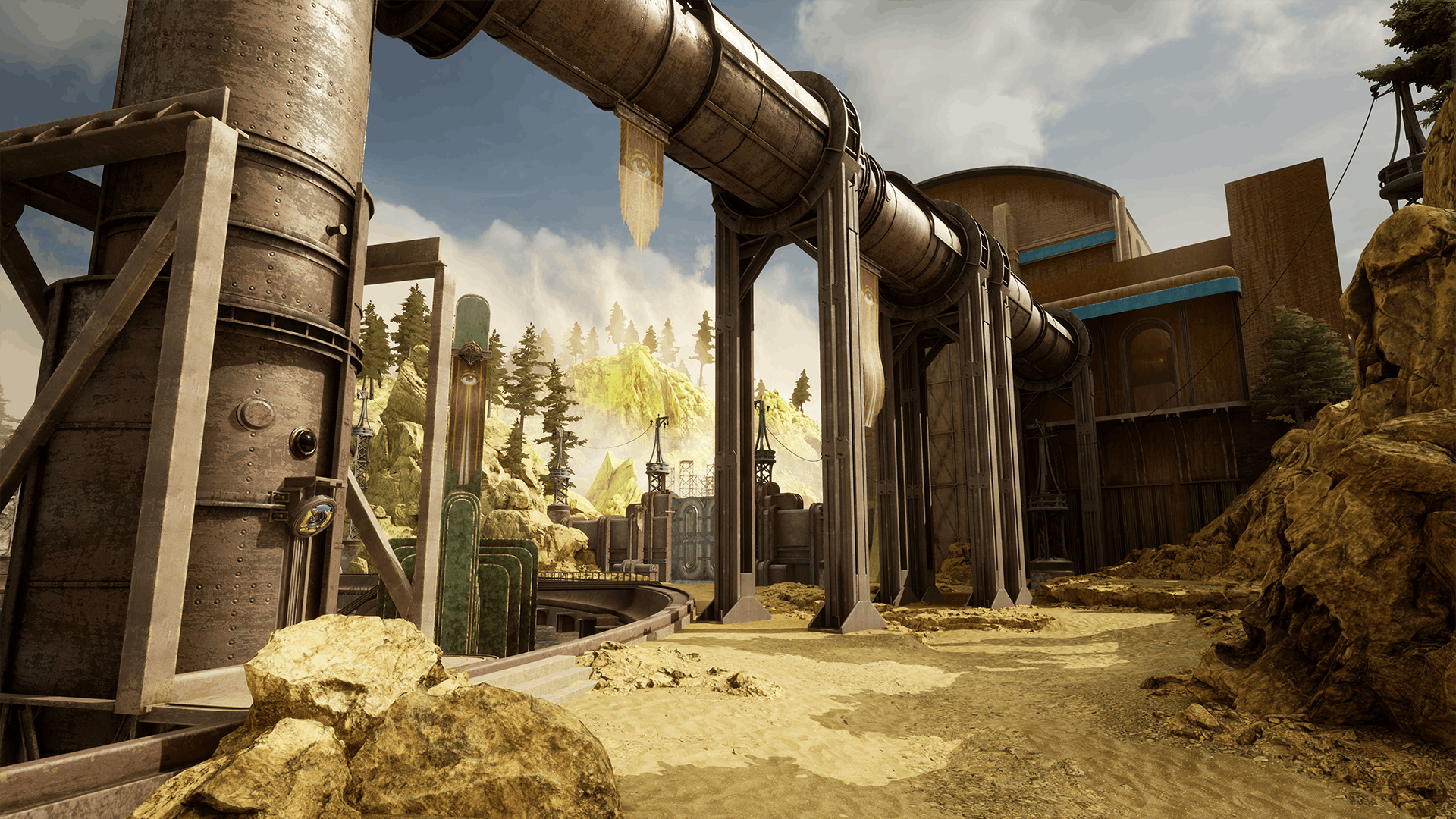
I can’t tell if the woman is a ghost or a hologram, but she’s definitely dead.
“I will lie to you,” she says.
We’re in a dark room that looks like a WWI bunker filled with pipes and pressure gauges. Outside, snow is falling on a high mountain pass, where massive steam-powered machines have been abandoned between the rocks and icefalls. The woman tells me more, but I’m already wondering: “What is she lying about?”
When I reach the top of the mountain to see what’s in the valley below, my mouth falls open. As an adult, video games rarely fill me with awe anymore. But suddenly I’m 13 years old again, exploring the islands of 1997’s Riven for the first time.
Crowdfunded by a $1.4 million Kickstarter campaign in 2019, Firmament is the new first-person puzzle adventure game from Cyan Worlds, the small indie studio behind two of the best-selling PC games in history, Myst and its sequel Riven. Like its predecessors, Firmament is beautiful and mysterious, with an immersive Riven-meets-Bioshock aesthetic and clever environmental puzzles that are seamlessly grounded in the story.
It’s the most fun I’ve had solving puzzles since Portal 2 way back in 2011, and it culminates in a narrative twist worthy of M. Night Shyamalan. But for a variety of reasons — budgetary constraints, a VR-first approach to world design, and a high-concept premise that isn’t truly revealed until the last moments of the game — Firmament left me wanting much more.
Welcome to the Realms

There are three “Realms” to explore in Firmament: ice-laden mountains, forested cliffs, and a coastal lagoon. The ghostly mentor I mentioned earlier, whose disembodied voice follows you around, says these Realms were once maintained by people who have since disappeared, leaving their steampunk infrastructure in a state of decay you’ll have to puzzle your way through. There’s also a brilliantly designed hub area that ranks among the most iconic structures Cyan has ever built, right up there with Myst’s library and Riven’s massive golden dome.
The exterior visuals are stunning. Everywhere you look is “back-of-the-box-worthy,” as they used to say in the days when you bought games from CompuServe. The landscapes are striking, with more verticality than any previous Cyan game. When you’re traversing the snow-covered peaks of the mountainous Realm, it really feels like you’re climbing the Swiss Alps, and the natural spires of the garden Realm are as staggering as the South China Karst. The art-deco-inspired architecture is also a joy to behold, from a cliff-spanning glass conservatory to the opulent tram stations you’re shuttled between in every Realm. The coastal region isn’t quite as distinct or attractive as the other two, especially compared to its psychedelically colorful concept art during the Kickstarter campaign, but its puzzles are among the game’s best.
On the other hand, many of Firmament’s interiors are oddly spartan, with very few signs of life. The world’s factories and depots are mostly filled with reused background assets, like nondescript crates and books. It’s particularly disappointing to finally arrive at the game’s mysterious superstructures and find them mostly empty and repetitive, with only small areas to explore and little to discover. The result is a world that’s beautiful but sterile — a stark contrast to the lived-in vibes that animated Myst, Riven, Uru, and Obduction.
Sockets and Sprockets

Firmament is the first Cyan game where you don’t pull any levers or push any buttons to operate abandoned machinery. Instead, all of the puzzles are solved by using your “Adjunct,” a steampunk hand prosthetic that fires a massive screwdriver head into hundreds of “Sockets” sprinkled throughout the world. Opening doors and maneuvering vehicles with the Adjunct is awkward at first, but once you get the hang of its bidirectional control system, it’s a satisfyingly tactile way to interact with the environment.
As for the puzzles themselves… well, I hope you like moving platforms around! Virtually all of Firmament’s brain teasers involve using the Adjunct to reposition catwalks and other flat surfaces in order to reach previously inaccessible areas. Unlike past Cyan games or similar titles like The Witness, the puzzles don’t reward your exploration or observations of the world. Instead, they merely test your spatial awareness and logic.
Limiting the interactivity to Sockets may make the game a smoother VR experience, but it can also make the (sometimes large) areas between Sockets feel like empty space to sprint through, instead of encouraging you to slow down and learn about the world. But given the way Firmament tells its story… that might have been intentional.
Building a Myst-ery

The central mystery of Firmament — what, when, and where are the Realms? — is a fascinating one that compels you to keep solving puzzles and exploring. Depending on how many clues you notice along the way, the answers revealed in the game’s final stretch will either shock you or feel like a satisfying confirmation of your predictions. Either way, the endgame elevates Firmament to a groundbreaking milestone in a long line of puzzle adventure games dating back to Cyan’s own Myst in 1993.
Even so, hiding so much about the story until the end comes with a cost: Firmament’s narrative is very thin, especially compared to Cyan’s past games, which are littered with in-character journals and environmental storytelling. I suppose it’s less fun to read long pieces of prose in VR than it is on a PC, which might explain why 99 percent of the exposition is delivered by the mentor’s dialogue, but she’s intentionally vague in order to preserve the endgame’s surprises. You never get a real sense of who she is, nor what the people who lived in the Realms were like, nor what their experiences were. Perhaps if the big reveal had come sooner, or if there was more game to play after it, Cyan would have had more opportunities to fill in the narrative gaps with lore. As it stands, exploring Firmament isn’t as richly layered or memorable as Myst, Riven, or Obduction because the Realms don’t have a comparable sense of history.
Nevertheless, Firmament is a magnificent achievement in visual worldbuilding that I’m still thinking about weeks later. I’m already back in the Realms, looking for Easter eggs I may have missed the first time. My desire to learn more about Firmament’s story is a testament to Cyan’s ability to make players care about fictional worlds, and its shorter runtime and smoother puzzle mechanics make it the most approachable game in the company’s history, as well as a perfect primer for the puzzle adventure genre at large. I truly hope Cyan keeps making worlds like this for decades to come.
8/10
Firmament is available on PC (for 2D and supported VR hardware) and Mac. Inverse reviewed the 2D PC version.
INVERSE VIDEO GAME REVIEW ETHOS: Every Inverse video game review answers two questions: Is this game worth your time? Are you getting what you pay for? We have no tolerance for endless fetch quests, clunky mechanics, or bugs that dilute the experience. We care deeply about a game’s design, world-building, character arcs, and storytelling come together. Inverse will never punch down, but we aren’t afraid to punch up. We love magic and science fiction in equal measure, and as much as we love rich stories and worlds, we won’t ignore the real-world context in which games are made.







